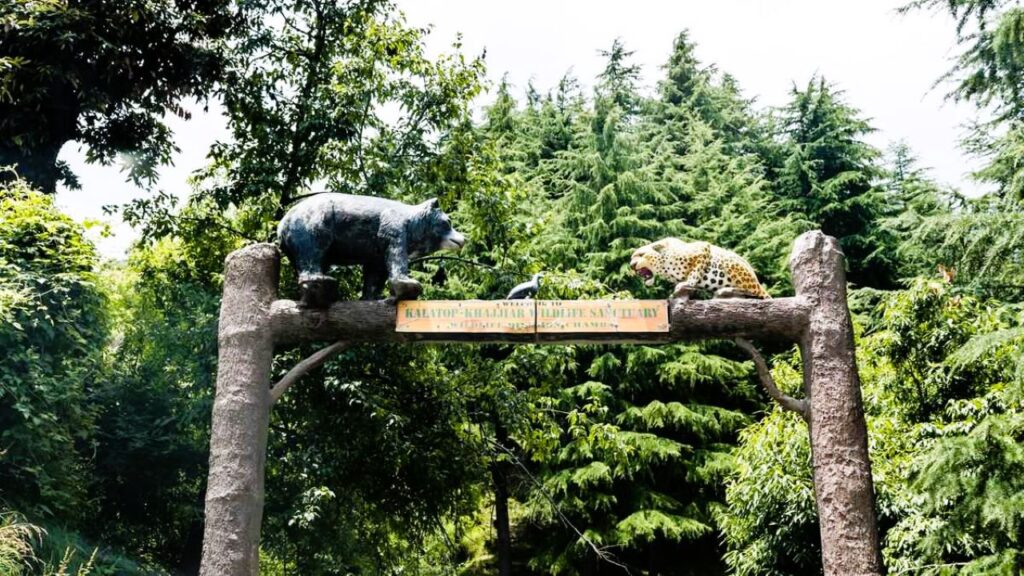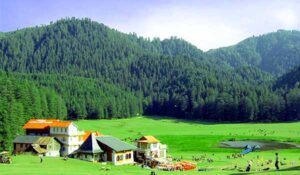The Kalatop Wildlife Sanctuary is one of the most popular wildlife sanctuaries in Himachal Pradesh. Spread over an area of 1962 hectares the sanctuary is irrigated by the Ravi River. One can see the beautiful hills, snow-capped mountains, the valleys, the villages, the rich greenery and the rockiness of the neighborhood from the place. The Sanctuary is a not to miss attraction near Dalhousie.
The Sanctuary has a well laid out path for trekking from Dalhousie to Kalatop which most of the tourists really enjoy. Jungle Safari is another highlight of the sanctuary that almost every visitor opts for along with families and children.
The plantation of the sanctuary consists of blue pine, deodar, oak forests and dense undergrowth. The sanctuary also houses a variety of wildlife like Bear, Himalayan Black Marten, Leopard, Deer, Barking Goral, Squirrel, Serow, Jackal, Langur etc. The most interesting being the Himalayan Bear.
In the middle of the sanctuary, there are open meadows with soft grass where animals have a treat. Many wildflowers grow in early summer including the daisies.
Flora and fauna of Kalatop wildlife Sanctuary
The vegetation consists of blue pine and deodar forest, with oak. Undergrowth in the forest area is well developed.
Mammals- bear, Himalayan Black Marten, leopard, deer, Barking Goral, squirrel, serow, jackal, langur.
Birds- Blackbird, Eurasian Jay, White winged Black Bird, Black Headed Jay, Chesnut Billed Rock Thrush, Blackheaded Jay, Grey Headed Cannery Fly catch.
Nestled in the picturesque landscape of the Himalayan foothills, the Kalatop Wildlife Sanctuary is a haven for nature enthusiasts and wildlife photographers. This sanctuary, with its rich biodiversity, offers a glimpse into the unique ecosystem of the region. In this article, we will explore the diverse flora and fauna that make Kalatop Wildlife Sanctuary a must-visit destination for anyone interested in the natural world.

Verdant Vegetation: A Lush Green Paradise
Kalatop Wildlife Sanctuary is renowned for its lush greenery, which forms a significant part of its charm. The vegetation here is primarily composed of blue pine and deodar forests, intermingled with oak. These towering trees not only add to the scenic beauty but also provide a vital habitat for numerous species. The undergrowth in the forest area is well-developed, consisting of a variety of shrubs, herbs, and small plants that contribute to the rich biodiversity of the sanctuary.
The blue pine, known for its striking blue-green needles, and the deodar, revered in Indian culture, dominate the landscape. The oak trees, with their robust presence, add a sense of timelessness to the forest. This combination of conifers and broadleaf trees creates a unique habitat that supports a wide range of wildlife.
Mammalian Majesty: A Glimpse into Wilderness
The mammal population in Kalatop Wildlife Sanctuary is as varied as it is fascinating. The sanctuary is home to several species, some of which are rare and endangered. The Asiatic black bear, an imposing yet elusive creature, roams the deeper parts of the forest. The Himalayan Black Marten, a small but significant predator, can occasionally be spotted darting through the trees.
Leopards, with their stealth and beauty, are one of the top predators in this ecosystem. Their presence indicates the health of the wildlife in the sanctuary. Deer species, including the graceful barking deer and the sturdy serow, are commonly seen grazing in the clearings. The barking goral, a unique species of wild goat, is another fascinating inhabitant of this sanctuary.
Squirrels, including the Himalayan striped squirrel, add a playful element to the forest. The jackal, often heard but seldom seen, contributes to the mysterious allure of the sanctuary. Langurs, with their acrobatic movements and social behavior, are a delight to observe.
Avian Abundance: A Birdwatcher’s Delight
Kalatop Wildlife Sanctuary is a paradise for birdwatchers, with its rich avian diversity. The sanctuary hosts a variety of bird species, making it an ideal spot for bird photography and observation. The blackbird, with its melodious song, is a common sight. The Eurasian Jay, known for its striking plumage and intelligent behavior, adds to the sanctuary’s charm.
The Whitewinged Black Bird, with its distinctive appearance, is a treat for bird enthusiasts. The Black Headed Jay and Chesnut Billed Rock Thrush are other notable species that adorn the sanctuary’s avian community. The Blackheaded Jay, a relative of the crow, is known for its intelligence and adaptability.
The Grey Headed Cannery Flycatch, a small but vibrant bird, is often seen flitting through the canopy, adding a splash of color to the green surroundings. These birds, along with many others, form an intricate part of the ecosystem, playing crucial roles in seed dispersal and insect control.
A Sanctuary for All
Kalatop Wildlife Sanctuary is not just a place for wildlife; it’s a refuge for nature lovers, researchers, and photographers. The sanctuary offers an opportunity to experience nature in its purest form. The diverse flora and fauna found here are a reminder of the delicate balance of our ecosystem and the need to preserve it.
Visitors to Kalatop Wildlife Sanctuary are encouraged to respect the natural habitat and observe wildlife responsibly. The sanctuary’s beauty lies in its untouched wilderness, and it is our collective responsibility to ensure that it remains a safe haven for the diverse species that call it home.
Kalatop Wildlife Sanctuary stands as a testament to the natural beauty and diversity of the Himalayan region. Its lush forests, diverse wildlife, and vibrant birdlife make it an exceptional destination for anyone looking to immerse themselves in nature. Whether you are a seasoned naturalist or a casual visitor, the sanctuary promises an unforgettable experience amidst the splendor of the natural world.



